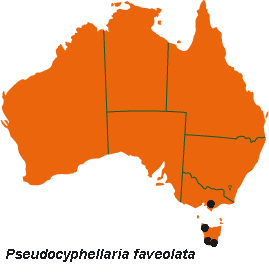



Australian Biological Resources Study
| Checklist of the Lichens of Australia and its Island Territories | ||
| Introduction | A–D | E–O | P–R | S–Z | Oceanic Islands | References | ||
| Pseudocyphellaria faveolata (Delise) Malme | ||
| Bih. Kongl. Svenska Vetensk.-Akad. Handl. 25(3/6): 23 (1899); Sticta faveolata Delise, Mém. Soc. Linn. Calvados 2: 101 ('1822') [1825]. T: Straits of Magellan, Chile, coll. unknown; lecto: BM, fide D.J.Galloway & P.W.James, Lichenologist 12: 298 (1980). | ||
| Thallus rosette-forming to irregularly spreading, loosely attached centrally, 5–12 (–20) cm wide; margins ±free and ascending. Lobes linear-elongate, 1–5 (–10) cm long, 2–15 (–30) mm wide, rather narrow and subdichotomously branching near apices, complex-imbricate centrally; apices ±furcate; lobe margins entire, thickened above and with prominent projecting white verruciform pseudocyphellae, sometimes thinly white-tomentose towards apices. Upper surface pale olivaceous, green-black or brownish when dry, lettuce-green to olive-green when wet, strongly reticulate-faveolate, coriaceous, without isidia, maculae, phyllidia, pseudocyphellae or soredia. Medulla white. Photobiont green. Lower surface pale buff to dark red-brown or black, thickly tomentose. Pseudocyphellae few to numerous, prominent, white. Apothecia mainly marginal or submarginal, subpedicellate; disc dark red-brown to black, grey-white-pruinose when young; exciple whitish to pale red-brown, corrugate-scabrid, persistent at maturity; epithecium dark grey-brown or olivaceous-brown, K+ vinous-purple; hymenium colourless to pale straw-yellow or pale yellow-brown, ±granular; hypothecium dense, opaque, orange-brown above, olive-brown to dark brown below. Ascospores ellipsoidal, 1–3-septate, 25–35 × 9–11 µm, smoky grey-brown. CHEMISTRY: Methyl virensate, physciosporin, hopane-6α,7β,22-triol, stictic acid, norstictic acid (trace), cryptostictic acid and constictic acid. |  |
|
| Occurs with certainty in southern Vic. and Tas. (earlier reports from Qld and N.S.W. are doubtful). In Tas. it is found in wet forest and scrub in habitats similar to those of P. billardierei. However, it is marginally less shade-tolerant and is mostly confined to the middle and upper trunks and branches of trees. Widespread in New Zealand and the subantarctic islands to the south, and from southern South America. | ||
| Galloway et al. (2001) | ||
| Checklist Index |
| Introduction | A–D | E–O | P–R | S–Z | Oceanic Islands | References |
This work is copyright. Apart from any use as permitted under the Copyright Act 1968, no part may be reproduced by any process without prior written permission from Australian Biological Resources Study. Requests and inquiries concerning reproduction and rights should be addressed in the first instance to Dr P. McCarthy. These pages may not be displayed on, or downloaded to, any other server without the express permission of ABRS.